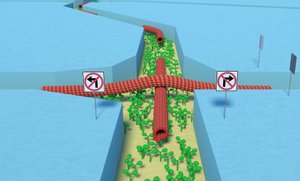Photo: Jesper Löfman
PARALLEL NETWORK-BASED BIOCOMPUTATION
Bio4Comp had two main goals:
(i) We aim to develop the technology required to scale up network-based
biocomputers to a point at which they are able to compete with other alternative
computing approaches such as DNA computing and quantum computing.
Follow technological development on our research pages
(ii) In the process, we aim to attract a larger scientific and economic community that will focus on developing the technology into a viable alternative computing approach.
See profiles of partners and associated partners
Follow us on social media!
Bio4Comp in the Swedish Radio Science News
Heiner Linke explains how biomolecules found in cells can pave the way for solving complex logistical problems that electronic computers cannot handle
Listen to the Science News clip about biocomputers (in Swedish)
Focus on Biocomputation: Materials, algorithms, devices and fabrication
Special Issue in the New Journal of Physics
Keywords: biological computation, parallel computing, subset sum problem, molecular motor, network-based biocomputation, nanofabrication, NP-complete problem, exact cover, microfluidics, e-beam lithography, actin, myosin, in vitro motility assay, electrostatic detection, nanoscale biosensors, interference reflection microscopy, microtubules, kinesin, gliding assay;
During 2021, the collection has grown to 8 articles and gives a comprehensive overview of the field. All articles are fully open access.
Special Issue in the New Journal of Physics
Bio4Comp, an EU-funded research project focuses on pushing the limit for what size of such problems can be practically solved. We call our approach "network-based biocomputation": The idea is that biomolecular machines, each only a few billionth of a meter (nanometers) in size, can solve problems by moving through a nanofabricated network of channels designed to represent a mathematical algorithm; an approach we termed “network-based biocomputation”. Whenever the biomolecules reach a junction in the network, they either add a number to the sum they are calculating or leave it out. That way, each biomolecule acts as a tiny computer with processor and memory. While an individual biomolecule is much slower than a current computer, they are self-assembling so that they can be used in large numbers, quickly adding up their computing power. How this works is explained in the video by ColdFusions TV below. Members of the Bio4Comp team have recently demonstrated in a publication in PNAS, that this approach works not only in theory but also in practice.
Imagine a computer chip that runs on a few nanogram of biochemical fuel rather than kilowatts of electrical power. In the video below Heiner Linke, coordinator of Bio4Comp, explains how that works.
Today’s supercomputers are limited mainly by two obstacles: First, they use vast amounts of electric power – so much that the development of more powerful computers is hampered primarily by limitations in the ability to cool the processors. Second, they are not very good at doing two things at the same time. This makes them particularly bad at solving certain problems such as the design of error-free computer chips and software, calculating efficient resource use in industrial processes, or predicting protein folding.
FUTURE AND EMERGING TECHNOLOGIES
Bio4Comp is a research project funded by the Horizon 2020 Research and Innovation Framework Programme of the European Union (grant agreement 732482). The project has received 6.1 million euros from the Future & Emerging Technologies (FET) programme to run the highly interdisciplinary action touching mathematics, biology, engineering, and computation. The collaborative project has an expected duration of five years (2017-2021) and aims for the exploitation of the motion created by molecular motors proteins in a unique manner to solve mathematical problems.
THE INTERNATIONAL TEAM OF RESEARCHERS
The consortium consists of six partners from Sweden, Germany, the U.K. and Israel. This international team of researchers and technologists is lead by Prof. Heiner Linke, Director of the Nano Science Center at Lund University (Sweden). The partners are TU Dresden (Germany), Prof. Stefan Diez group; Linnaeus University in Kalmar (Sweden), Prof Alf Månsson group; Molecular Sense Ltd. (UK), Dr. Dan Nicolau, CEO; Bar-Ilan University (Israel), Dr. Hillel Kugler group; and two Institutes (Fraunhofer ISC and Fraunhofer ENAS) of the Fraunhofer- Gesellschaft (Germany).






